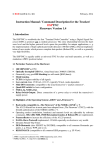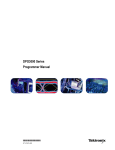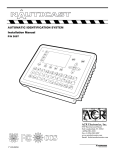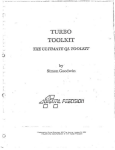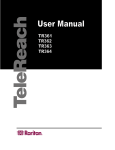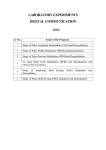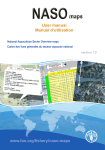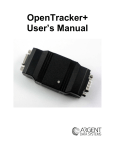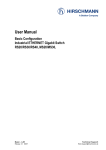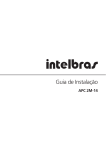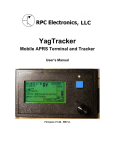Download Instruction Manual / Command Description for the Tracker
Transcript
© SCS GmbH & Co. KG
June, 2007
Instruction Manual / Command Description for the Tracker/
DSPTNC
Firmware Version 1.1
1. Introduction
The DSPTNC is worldwide the first "Terminal Node Controller” using a Digital Signal Processor (DSP) as protocol and as modem processor. The close relationship between the hardware level and the higher protocol levels opens the possibility for unique applications, e.g the
implementation of high sophisticated multi-detectors (300 Bd AFSK), efficient implementation of new modes which process complete data packets (Robust-PR), as well as a generally
very high flexibility.
The DSPTNC is equally usable as universal TNC for chat- and mail operation, as well as a
stand alone APRS1-position tracker.
1.1 Particular Features of the Hardware:
•
•
•
•
•
•
•
•
•
•
100 MIPS DSP as CPU.
Optically decoupled USB-Port, virtual baudrates 38400/115200 Bd.
Generically very good HF-blocking (no selfmade QRM (hum)).
Metal housing.
TCXO for highest stability of all signals.
Low current drain 15-90 mA (13.8 V), typically 50 mA, mode dependent.
Mini-DIN-connector, compatibel to the usual transceiver’s “packet connector“.
Quad-DIP-switch for basic configuration.
NMEA-In, NMEA-Out.
Relais-Switch-Output: Direct connection of a power relay to switch the tranceiver’s supply power.
1.2 Highlights of the Operating System („BIOS“ und „Firmware“):
•
•
•
•
•
•
•
1
2
Backwards compatible to „The Firmware“ of the NORK><LINK2 e. V.
The AX.25-Kernel has in most parts been adopted from „The Firmware“ (TNC2), with the
friendly authorisation of the NORD><LINK e. V.
Operating modes (modulation, baudrate) and transmit levels are adjustable by software
commands, 300, 1200, 9600, 19200 Bd-standard-modes & Robust-PR are implemented.
Framecollector to increase the efficiency of the AX.25-protocol.
DAMA-Slave-Protokoll implemented - DAMA especially on shortwave very useful.
Dynamic Round-Trip-Timer.
DED-Hostmode (also XHOST by DG3DBI), compatible to all common Hostmode programs, e. g. Paxon, WPP, and so on.
KISS/SMACK (compatible to all common KISS programs, e. g. UI-View).
APRS is registered trademark of the APRS Engineering LLC, USA.
NORK><LINK e. V., http://www.nordlink.org
1
•
•
•
Firmware upgrade via USB connection.
Permanent storing of all parameters possible.
High reliability through the separation of the BIOS and underlaying application („Firmware“).
2
2. Basic Configurations by the DIP-Switches:
Tracking-Mode, BIOS (Firmware-Update), setting of the virtual baudrate (USB)
The 4 DIP-switches at the frontside of the DSPTNC are numbered consecutively from left to
right from 1 to 4. (1=Tracking, 2=Baudrate, 3=BIOS, 4=Option). Standard position (upper
position) means „disabled“ („OFF“), lower position means „enabled“ („ON“).
DIP-Switch 1: Tracking
OFF: Normal TNC-Mode, DSPTNC operates as universal TNC.
ON: DSPTNC operates in energy saving Tracking-Mode for position tracking.
In Tracking-Mode the DSPTNC consumes less than 20 mA at 13.8 V operating voltage.
Therefore, this mode is suitable for long term position tracking combined with limited battery
capacity, especially as the power of the transceiver can also be switched. In result, the average
power consumption when using e.g. half hour beacon intervals is very small.
As soon as the Tracking-DIP-switch is activated and the (few) necessary conditions for APRS
beacon operation are fulfilled (“Mycall“ set (see I-command), position is known (GPS or
FIX), %A set to 1 or 2 (see %A-command)), the TRK-LED (second from left) should flash
red regularly several times per second. With this the TRK-LED indicates, that the TNC is
now operating correctly in “Tracking-Mode“. Note: During this waiting period (TRK-LED
flashing red) the DSPTNC cannot process any commands from the PC interface, nor receive
signals from the transceiver port.
If the TRK-LED is permanently showing red, the “Tracking-Mode“ could not be activated
because of one (or more) important condition(s) for the transmission of APRS-datagrams is
not yet fulfilled. Permanently lighting of the TRK-LED means „Tracking-Mode Error“. In
this case the „Tracking“-DIP-switch must be set to „OFF“ again to be able to change and to
correct the DSPTNC-configuration.
If the DSPTNC is in Tracking-Mode, it switches on the transceiver (via the relais output) 10
seconds before the next APRS beacon is scheduled and checks, if the HF/VHF/UHF channel
it free (DCD). During this phase the TRK/STA-LED flashes alternating red/green. If the
channel is free after the expiry of the 10 seconds minimum waiting time, the APRS datagram
will be transmitted. Afterwards the transceiver will be switched off again and the waiting
condition is resumed (red flashing TRK-LED).
If the channel is occupied, the DSPTNC waits for additional 20 seconds maximum for the
channel to become free. If this does not happen in this time then the DSPTNC goes back into
the waiting condition without having transmitted the APRS-datagramm.
DIP-Switch 2: Baudrate
The baudrate-DIP-switch is read in just once at power on of the DSPTNC. It defines the speed
(baudrate) of the virtual COM-port (USB).
OFF: 38400 Bd.
3
ON:
115200 Bd.
DIP-Switch 3: BIOS (Possibility to update the operating system)
Der BIOS-DIP-switch is read in just once at power on of the DSPTNC and defines if the
DSPTNC starts the application software (“Firmware“).
OFF: Application software (“Firmware“, Packet-Radio) will be startet, if installed. The
PWR/NMEA-LED shines green as soon as the BIOS has started the firmware.
ON:
DSPTNC remains in BIOS mode, it does not start the “Firmware“.
Now via the BIOS an update of the whole operating system can be performed (BIOS
& Firmware). The PWR/NMEA-LED shines red in this case.
Being in BIOS mode, the DSPTNC can be updated with the help of an update tool running on
the PC (e. g. TRConfig or Tracker_Update.exe), which means that a new operating system
can be loaded into the DSPTNC. Valid update-files have the extension .TRK, e. g.
FW1_1.TRK.
While the update is in progress, the LED’s lit consecutively green (cyclic). This process usually only replaces the application software (“Firmware“), the BIOS itself remains unchanged.
In special cases it can be necessary the renew the BIOS as well. If the BIOS-DIP-switch is set
to OFF again while the DSPTNC is still in BIOS mode, and the update process is started afterwards, then the update process replaces both, BIOS and firmware!
A BIOS-update, however, carries a certain amount of danger that the BIOS will be destroyed
in the case of loss of power (or other problems) during the update procedure. Because of this,
updating the BIOS should only be done in rare cases! If the DSPTNC no longer contains a
correct BIOS, it can only be reactivated by a service technician.
DIP-Switch 4: Option
The Option-DIP-switch is read in just once at power on of the DSPTNC and defines, if the
DSPTNC uses the default or the user-defined configuration.
OFF: The configuration parameters stored by the user with the %ZS command will be loaded at power-up.
ON:
The default configuration parameters (off factory) of the DSPTNC are loaded at
power-up. (This configuration can then be stored with the %ZS command, which deletes any previously stored user defined configuration.)
4
3. Configuration by Software Commands
The Configuration Program TRConfig
The easiest way to do the configuration of parameters being adjustable by software commands
is to use the PC-program TRConfig, which has been created especially for this purpose.
TRconfig translates the desired properties of the DSPTNC, given as easy symbols in a graphical user interface, into commands and sends those to the DSPTNC, and also permits the permanent storing of the complete configuration into the non-volatile memory of the DSPTNC.
The basic configuration requires the own callsign (“Mycall“), the desired Packet-Radio operation mode as well as the transmit output level(s) to modulate the transmitter. For APRS it can
be necessary to enter the position (if no GPS receiver is connected), the beacon timer intervall
as well as the APRS symbol (your own symbol that appears on an APRS-map) and the desired APRS mode („FIX“, which is a manually entered fixed position, or „GPS“) as basic configuration.
The available Commands of the DSPTNC Operating System
The DSPTNC comes with two different modes to communicate or to exchange data on the
USB connection to the computer: Terminalmode and Hostmode. After power-on the TNC is
always in Terminalmode and can be accessed with an easy terminal program like Windows
HyperTerm. For data transparent multi channel operation it is recommended to use the socalled hostmode, which can be activated by command and is supported by many PC programs
designed for Packet-Radio operation.
Command interpreter as well as hostmode adhere closely to “The Firmware“ by
NORD><LINK e. V. and therefore are backwards compatible to “The Firmware“ (TNC2).
The DSPTNC makes use of 11 virtual channels for Packet-Radio, which are one monitorchannel (0) and 10 channels for Packet-Radio-connects, which mans that 10 parallel PacketRadio connects can be established the same time.
In terminal mode every command must be preceeded with the ESC-character (ASCII 27) to
open the command interpreter. Otherwise the characters being entered are sent to the currently
selected virtual channel (see command S). In the case that the virtual channel is not connected, this characters usually are ignored, which means discarded. In channel 0 however,
they are interpreted as unproto information and (after a CR as termination) transmitted as a
part of an unproto packet.
Apart from a few exceptions, nearly all commands are available in terminal mode as well as
in hostmode. In hostmode the operation of the DSPTNC is mainly given by the PC programm
used.
3.1. To “The Firmware“ (NORD><LINK) compatible Commands
Concerning the standard commands the DSPTNC behaves compatible to a TNC2 with
„TF2.7b“ as operating system. The following commands are available:
A (Add-Linefeed)
5
Default: 1
Possible parameters: 0, 1
Automatic insertion of a Linefeed-charcter <LF> after a CARRIAGE RETURN <CR> to the
terminal. 1 = yes, 0 = no.
B
Default: none
Possible parameters: none
Counts the number of the round trips of the main software loop per socond. This number allows conclusions about the internal processing speed of the TNC firmware. This command
was left remaining just for compatibility reasons but has no relevance to for the user.
C (Connect)
Default: Possible parameters: Target call (if required, followed by up to 8 digipeater-callsigns)
Example: C DL6MAA DB0UAL (DL6MAA shall be connected via DB0UAL.)
The C-command is used to establish a connection to a distant station. It is not necessary to
enter a 'v' or 'via' between the target call and the digipeater calls. A C-command invoked on
channel 0 defines the path for unproto (UI) packets.
D (Disconnect)
Default: none
Possible parameters: none
An existing connection will be disconnectet. If after entering the "D" command there is still
information being send or confirmed, the "Disconnect" will be carried out when the last information packet is received and confirmed. If the D-Command is repeated, this process can
be cancelled. If the D-command is invoked while a connect or a disconnect is in progress, the
TNC immediately resumes the disconnected condition and automaticly sends a DISC-frame to
prevent unnecessary transmissions for the case that the own TNC did not copy the answers of
the distant station.
E (Echo)
Default: 1
Possible parameters: 0, 1
Enables/disables the echoing of entered characters (data or commands) to the terminal. 1 =
yes, 0 = no.
To avoid problems with terminal programs with echo enabled, non printable characters are
replaced with a ".". Just BELL and TAB are transparently echoed to the terminal.
F (Frack)
Default: 500
6
Possible parameters: 1...15000
„Frack“ is the maximum waiting time between the transmission of a packet and the confirmation by the distant station. (Afterwards a request back will be sent). With “The Firmware“
Frack is implemented as a dynamic “Round Trip Timer“ which adapts to the actual channel
activities. The value set with the F-command serves as the start value for the automatism.
The time can be entered directly in seconds. With entries < 16 the value will be multiplied
with 100 and then divided by 2. Entries > 15 are directly interpreted as milliseconds (L2„Round Trip Time“).
G
Default: none
Possible parameters: 0, 1
Request of the virtual TNC-channels in hostmode. In terminal mode this command is not
valid and an error message is issued.
Effect of the parameter:
Channel 0:
G (without parameter):
G0:
G1:
Channel > 0: G (without parameter):
G0:
G1:
Linkstatus/Monitorheader/Monitorinfo
Monitorheader/Monitorinfo
Linkstatus
Linkstates/Infoframedata
Infoframedata
Linkstates
I (Mycall)
Default: DSPTNC
Possible parameters: CALSIG (own callsign, maximum 6 characters plus SSID.)
Entry of the own callsign („Mycall“). For each virtual TNC-channel an own callsign can be
entered. After a “Disconnect“ the callsign of channel 0 is adopted.
ATTENTION: The DSPTNC only transmits after a callsign has been entered, but not with the
default callsign “DSPTNC“ as “Mycall“!
JHOST (Hostmode)
Default: 0
Possible parameters: 0, 1
Switches between terminalmode und hostmode. The hostmode is WA8DED-compatible and
is supported by many PC-application programms (e. g. terminal programms).
K (Timestamp)
Default: 0
Possible parameters: 0, 1, 2 or Time and Date
7
Activation of the “Timestamp“-function and setting of the implemented 24-h clock with calendar. (A “Timestamp“ is an additional timestamp at linkstatus outputs as well as monitor
outputs).
Possible parameters:
K (without parameter)
K0
K1
K2
shows Timestamp-parameters and date/time
Timestamp disable
Timestamp enabled at status outputs
Timestamp enabled at status and monitor outputs
K 20.02.88
K 02/20/88
K 17:36:00
Sets date, European version
Sets date, American version
Sets clock
L (Linkstatus)
Default: none
Possible parameters: 0...10
The L command displays the linkstatus of one (channel number as parameter) or all (no parameter) virtual channel(s). Displayed are routing information (call and list of digipeaters),
quantity of received frames, quantity of not yet sent frames, quantity of unacknowledged
frames and the retry counter respectively. The respective channel in use is marked with a '+'
character.
M (Monitor)
Default: N
Possible parameters: N, U, I, S, C, +, - (multiple parameters simultaneously possible)
Activation and configuration of the monitor mode. The parameters define which frames shall
be displayed.
Possible parameters:
N
I
U
S
C
+
-
Monitor disabled
Information (I-Packets)
Unproto transmissions (UI-Packets)
Control-Packets
Monitor even whilst connected
<List of up to 8 calls >: only packets from this sender
< List of up to 8 calls >: no packets from this sender
The combined usage of '+'- and '-'-parameters is not supported. They have to be entered as last
parameter directly before the calls. The entry of '+' or '-' without call(s) deletes the actual list.
Interpretation of SSID’s is not supported!
N (Retry-Counter)
8
Default: 10
Possible parameters: 0...127
Configures the Retry-Counter. The entered value defines how many times a packet transmission shall be repeated in the case of error. (0 = unlimited). For every channel a separate value
can be entered. After RESET or disconnect the value being defined for channel 0 will be restored. Do NEVER set this value to 0 in the case of unattended operation!
O (MaxFrame)
Default: 2
Possible parameters: 1...7
Maximum allowed number of unacknowledged and unanswered information packets (IFrames). For every channel a separate value can be entered. After RESET or disconnect the
value defined for channel 0 will be restored.
P (Persistence)
Default: 32
Possible parameters: 0...255
Persistence-configuration. Without parameter the current setting is displayed. With DAMAoperation the Persistence value is ignoriert!
R (Digipeating)
Default: 1
Possible parameters: 0, 1
Enables / disables the digipeat-function. 1 = on, 0 = off.
S (Switch channel)
Default: 0
Possible parameters: 0...10
Selects between the virtual channels (0 = Monitor channel).
T (TX-Delay)
Default: 25
Possible parameters: 0...127
Delay between keying of the transmitter and start of the data transmission itself. („TXDelay“). The values are entered in 10 ms steps. Please evaluate and set an as low as possible
value by experiment.
U (Connect-Text, „C-Text“)
Default: 0
9
Possible parameters: 0, 1 [optional CText], 2 [optional CText]
With the U-command one has the possibility to automatically transmit a small amount of text
to the distant station when a connect is received (“C-Text“). The defined text also remains
stored when the U parameter is set back to 0. With 'U2' the TNC can be forced to disconnect a
current connection at receipt of the string "//Q" (in Terminalmode only!). For that, the string
"//Q" must be at the beginning of a single packet. This function is disabled in hostmode.
Examples:
U 1 Terminal offline
U1
U 2 Terminal offline
U0
U
Entering and activating the C-text „Terminal Offline“.
Activates already existing C-Text.
Entering and activating the C-text „Terminal Offline“ incl. //QFunction.
Disabling C-Text.
Displaying C-Text.
V (Version)
Default: none
Possible parameters: none
Displays a string which contains information about the currently installed software version.
W (Slottime)
Default: 10
Possible parameters: 0...127
Defines the „Slottime“ in milliseconds. Without parameter the current setting is displayed.
The W-value is ignored at DAMA operation. The TNC always goes to transmit immediately.
X (PTT)
Default: 1
Possible parameters: 0, 1
Controls the PTT line of the TNC. If necessary the keying of the radio can be suppressed, e. g.
when a channel shall be observed and it shall be prevented that the TNC replies to an incoming connect with a “busy” packet. 1 = normal PTT-operation, 0 = PTT always deactivated.
Y (Number of channels)
Default: 10
Possible parameters: 0...10
Defines the maximum number of simultaneously allowed connections until the next connecting station is rejected with a “busy”. Without argument the number of currently connected
channels is displayed in the form "maximum number of channels (used channels)" (General
limitation: The number of used channels can only be determined correctly when on all channels the same Mycall is used, as defined for the monitor channel S0). Example-displayed:
10
"10 (0)".
Z (Flow-Control)
Default: 3
Possible parameters: 0...3
.
Enables / disables the flow-control and the XON/XOFF-handshake to the terminal. With
flow-control enabled the TNC does not send characters to the terminal while data or commands are entered. With flow-control disabled characters are immediately sent to the terminal, independent of whether a line of text or a command is currently entered.
If the XON/XOFF-handshake is enabled, the dataflow from the TNC to the terminal can be
stopped with Ctrl-S and started again with Ctrl-Q.
Possible parameters:
0
1
2
3
Flow-control
Flow-control
Flow-control
Flow-control
off,
on,
off,
on,
XON/XOFF
XON/XOFF
XON/XOFF
XON/XOFF
off
off
on
on
@B
Default: none
Possible parameters: none
Displays the quantity of free TNC buffers.
@D (Duplex)
Default: 0
Possible parameters: 0,1
Switches on / off the full duplex operation. 0 = off, 1 = on.
@F (Flags)
Default: 0
Possible parameters: 0,1
Send flags in pauses. 0 = no, 1 = yes.
@I (Ipoll)
Default: 60
Possible parameters: 1...256
Defines or displays the value for the maximum length of the IPOLL-frame. (Not valid with
DAMA!).
11
@K (KISS/SMACK)
Default: none
Possible parameters: none
Enables the KISS/SMACK-mode. With the decimal byte-sequence 192, 255, 192, 13 the TNC
can be returned to normal operation without RESET (power off/on).
@T2 (Timer 2)
Default: 150
Possible parameters: 0...100000
AX.25-“Timer 2“: Interval before the acknowledgement of a received packet (in 10 ms steps,
150 means 1.5 seconds)
@T3 (Timer 3)
Default: 18000
Possible parameters: 0...100000
AX.25-„Timer 3“: Time the TNC waits for a ‘sign of life’ from the distant station when
connnected. After T3 is elapsed, the distant station is requested if it is still ready to receive.
@U (UI-Poll)
Default: 0
Possible parameters: 0, 1
Enables or disables UIPOLL (1 = UI+, 0 = UI).
@V
Default: 0
Possible parameters: 0, 1
Enables or disables the call check (1 = yes, 0 = no).
12
3.2 DSPTNC-specific Commands
(Extension of the „Standard-TNC-Command Set“)
APRS-Commands/Configuration for „Stand Alone“-Position Tracking
“Stand alone” means position tracking that works without a PC being connected. The actual
position data is sent in regular intervals in APRS format. The position can be entered either
manually (“Fix-operation” “Mode %A2“) or received from a connected GPS receiver (“GPSoperation” “Mode %A1“).
For setting up the APRS-function, several commands are available, always beginning with
%A.
APRS-datagrams are always sent with the Packet-Radio modulation mode previously set with
the %B-command.
Important:
The APRS-beacon uses as sender callsign the Mycall (see I-command) of the virtual
channel 0 or the optional/special APRS-Mycall (%AM) if it was defined. As long as no
callsign is defined, the APRS-beacon cannot be activated.
Additionally the DSPTNC must be supplied with a valid position via NMEA-port (GPSinformation) in mode %A1, or with a fixed position in mode %A2, entered with the help
of the %AO-command – otherwise the Tracker cannot transmit a position beacon.
The following functions are available:
%A (APRS-main switch)
Default: 0
Possible parameters: 0, 1, 2
This „APRS-main switch“ serves to setup the APRS-mode:
0:
OFF, APRS-beacon is switched off.
1:
GPS, APRS-beacon transmits GPS data, if available.
2:
FIX, APRS-beacon transmits the fixed position data (settable with %AO), if available.
In GPS-mode the beacon only transmits when the position information is not older than
the timeout interval defined with the %AV command (default 20 minutes). If the GPS
receiver fails, the beacon stops the transmission after expiry of the timeout interval. Also
refer to the %AI-command.
%AT or %AB (APRS Timer)
Default: 900
Possible parameters: 0, 10...7200
13
Defines the beacon interval in seconds. With the default setting of 900 the beacon transmits
every 15 minutes, if position data is available and the “global Mycall” on virtual channel 0
and/or the optional/special APRS-Mycall (%AM) is set.
Parameter 0 activates the speed dependent automatic operation: The interval calculates with
the equation: Intervall [sec] = 1800/GPS-speed [knots]. The interval is limited from 180 knots
to its minimum of 10 seconds. At speeds lower than 1 knots the interval is limited to a maximum of 1800 seconds.
This automatic can only work propery when the speed information is contained in the received GPS data, which means that the receiver provides RMC data sets. If no speed information is available but automatic operation is selected, then the interval is set to 900 seconds. At
„FIX“-position operation (%A2, see above) and automatic timer, the firmware sets the interval independent from the speed data of an eventually connected GPS receiver to 1800 seconds.
Speed dependent automatic tracking mode (set DIP-switch 1) is also possible, but with the
limitation that the Tracker does not read GPS data during the sleep-phase and does with this
not dynamically adapt the actual interval. It calculates the next interval out of the speed information available short term before the next sleep phase.
%AC (APRS Comment)
Default: NONE
Possible parameters: - or maximum 80 characters of comment text
Defines the comment text that is added to every APRS-datagram. For example, a brief description of the system can be included here: “{DSPTNC} 20 W, Dipole”. The comments
maximum length is 80 characters. Longer comments will be rejected with an error message. A
minus character (-) as first comment character sets the comment to “NONE”, respectively
deletes the comment.
APRS comments should be as short as possible, since longer APRS-datagrams lead to a (unnecessary) high channel occupation.
%AD (APRS digipeating)
Default: 0
Possible parameters: 0...3
Configures APRS-digipeating.
„RELAY“ and „WIDE“ as digipeating aliases will be replaced at digipeating with the global
Mycall (I-command at channel 0).
The parameter is defined as follows:
0: No APRS-digipeating.
1: „RELAY“ as digipeating alias.
2: „WIDE“ as digipeating alias.
3: „RELAY“ and „WIDE“ as digipeating alias.
14
%AE (APRS status Every)
Default: 0
Possible parameters: 0...20
The %AE-parameter defines the frequency of the interspersed status reports (see %ARparameter). With a value of 0 (default), the Tracker never sends the status report. With a value
of e.g. 3, after every third APRS-position packet a separate status-report packet will be transmitted, exactly 5 seconds after the beginning of the position packet.
Background: The separately transmitted status report can be used alternatively to a long
APRS-comment (%AC-parameter). If somebody e.g. sends the description of his equipment
not as APRS-comment but as status report, the APRS-position packet itself remains very
short. This increases the probability that the important position information (which is only
contained in the APRS-position packet and not in the status report) will properly be received
and decoded. Less important and not varying information can this way easily (and with lower
frequency) be interpersed as a status report.
%AH (Tracking, HF mode toggle)
Default: 0
Possible parameters: 0, 1
Sets the modulation in tracking-mode (DIP-switch 1 set to ON) with APRS-beacon transmissions to alternate between 300 Bd (A)FSK and 300 Bd RPR, independent of the setting of the
modulation which has been defined with the %B-parameter! (But the %B-parameter must be
set to a value smaller than 1200, otherwise the %AH-parameter will be ignored. This will prevent the station from accidentally transmitting the 300-Bd-waveform via a VHF-digipeater.)
The demodulator will also be set to the correct modulation before the transmission begins.
This ensures the correct operation of the DCD-function with the %AH1 setting.
Important: With 300 Bd (A)FSK and with %AH1, generally the audio center frequency is set
to 2000 Hz, independent of the %F-parameter. This achieves compatibility with the convention, that with FSK/RPR-channel pairs, the audio center frequency of the FSK-signal must
always be 500 Hz above the center frequency of the RPR-signal.
Also refer to: http://www.scs-ptc.com/rpr.html
The VFO-frequency of the transceiver in %AH1-operation must be set in a way, that for FSK
as well as for RPR the channel is hit exactly. Using the standard frequencies on 10 and 14
MHz, this is the case when the display of the transceiver shows 10147.3 kHz (USB) or
14103.3 kHz (LSB).
Background: Up to now (June 2007) significantly more FSK-Gateways than RPR-Gateways
exist on short wave channels. If, besides the robustness of the RPR-mode, also the existing
FSK-infrastructure shall be used, it is recommended to transmit position data in alternating
FSK/RPR-mode.
%AI (APRS tImestamp)
Default: 1
15
Possible parameters: 0, 1
Enables (1) or disables (0) the APRS-“Timestamp“-function. With “Timestamp“ enabled the
DSPTNC adds time information (UTC-time and date) to every APRS-transmission received
via the NMEA-port (GPS). Of course this is only possible if the data received from the GPS
receiver also contains the time information at all. If the GPS time information can be transmitted in the APRS datagrams, then the 20 minutes of GPS-timeout is not applicable any more. If
the GPS-receiver fails, APRS datagrams are also transmitted after the expiry of the 20 minutes, but with the old time information, of course. (Important is that the position and the time
at the position belong together.)
%AM (APRS Mycall)
Default: NONE
Possible parameters: Max. 6-characters callsign with SSID
Defines the (optional) APRS-Mycall. If it is set to NONE, then the global Mycall is used as
APRS-Mycall. The APRS-Mycall can be set invalid using the argument „NONE“.
Using separate APRS-Mycalls can be useful, if e.g. several different APRS-systems are operated with different SSID’s or if a digipeater shall transfer APRS-data as well as normal
Packet-Radio (with different SSID’s), etc.
%AN (APRS Nmea-out)
Default: 0
Possible parameters: 0...3
Physical format: 4800 Bd, 8N1, TTL.
The following modes can be set with the possible parameters:
0:
NMEA-Out is disabled.
1:
APRS-data received on the HF-port (source call, latitude, longitude) are presented as NMEAsentence ($GPWPL) at the GPS-port of the DSPTNC/Tracker. This kind of data can be used
by appropriate GPS-receivers as waypoint information and can be displayed on the screen of
the receiver, matched into a map.
2:
APRS-data received on the HF-port are presented in the usual monitor format at the GPS-port.
This is helpful e.g. to establish an APRS-gateway (with RX-function only) using a PC or a
controller without USB.
3:
Loopback mode. The Tracker/DSPTNC presents the data received at the GPS-port („NMEAin“) unchanged at the NMEA-out port.
Data is presented at the NMEA-out port also when the DSPTNC is running in KISS-Mode or
in Hostmode.
16
%AO (APRS pOsition)
Default: NONE
Possible parameters: XXXX.XXS/N YYYYY.YYW/E
Enables the entry of a position for the “FIX“-operation (Mode %A2, see above). The position
must be entered matching exactly the required „Latitude Longitude“-format, which is degrees
including leading zeros, directly followed by minutes with 2 decimal digits and finally the
direction. All deviating formats are rejected with an error message.
Example: %AO 4810.30N 01030.25W <Enter>
A „FIX“-position can only be replaced by a new „FIX“-position, but not completely deleted.
%AP (APRS Path)
Default: APRS via RELAY WIDE
Possible parameters: APRS-target callsign and maximum 8 digipeater callsigns.
Defines the AX.25 transmit path including target callsign and maximum 8 digipeater callsigns, also with their respective SSID if necessary.
Example:
%AP CQ via RELAY <Enter>
%AP APRS RELAY WIDE GATE <Enter>
Between the target callsign and (optionally) the digitpeater list, a “v” or “via” can be inserted
to increase readability.
A description of the function of current APRS-digipeater callsigns is beyond the scope of this
user manual. Appropriate information can be found in relevant literature e.g. Internet. If there
is no exact information of available digipeaters available, it is recommended to set “RELAY”
as the first digipeater.
%AR (APRS status report)
Default: NONE
Possible parameters: Up to 80 characters long string (text)
The command %AR serves to define an up to 80 characters long “APRS status report“. In the
status report, usually additional information besides the APRS-position beacon is transferred.
With the argument “-“ the status-report-text can be deleted or deactivated, respectively set to
“NONE“. The frequency of the status-report transmission is set with the %AE-parameter (see
there). Status-reports are generally sent by the DSPTNC/Tracker as separate AX.25-packets.
The (AX.25-) path is identical to that of the APRS-position packets.
%AS (APRS Short, data compression)
Default: 1
Possible parameters: 0, 1
17
Activates (1) or deactivates (0) the compression of the position data in the APRS-datagram.
The compressed format actually only has advantages: Shorter datagrams, higher accuracy, and
speed and direction can be included in the transfer. However, because some APRS-programs
cannot correctly interpret the compressed format, the DSPTNC firmware allows the compression to be switched off. Uncompressed position data can be directly monitored as usual in
“Latitude Longitude-format”, as they are sent in clear text format.
%AV (APRS Valid)
Default: 1200 [sec]
Possible parameters: 10...3600 [sec]
Defines how long the (old) GPS-data is valid for APRS in the %A1-mode (“GPS-mode“).
%AY (APRS sYmbol)
Default: 15 [Dot]
Possible parameters: 1-94, a1-a94
Sets the graphic APRS symbol that an APRS-receiving station should display: e. g. a symbolic car in mobile service (Symbol 30). The symbol numbers follow exactly the table in the
APRS-protocol version 1.0. The complete protocol information is available on the Internet.
Symbols from the alternative table (“alternate table”) can be selected by prefixing an “a” before the symbol number. E. g. “%AY a13” for “House (HF) ”.
If no symbol number is given as an argument, the “% AY” command displays the actual parameter settings with the current symbol and additionally a short description in square brackets, e. g. “A13 [House (HF)]”.
Here is a selection of current symbols with their numbers:
6:
7:
13:
a13:
15:
27:
28:
30:
47:
50:
53:
56:
57:
65:
66:
70:
74:
75:
83:
HF Gateway
Small Aircraft
House QTH (VHF)
House (HF)
Dot
Campground
Motorcycle
Car
Balloon
Recreational Vehicle
Bus
Helicopter
Yacht (sail boat)
Ambulance
Bicycle
Fire Truck
Jeep
Truck
Ship (power boat)
18
86:
Van
%AX (APRS beacon on tracking mode only)
Default: 0
Possible parameters: 0, 1
Enables (0) or disables (1) the APRS-beacon during normal TNC-operation. If %AX is set to
1, APRS-datagrams are only transmitted with “Tracking”-DIP-switch set to “ON“. This has
the advantage that one can easily switch between APRS mode and normal TNC mode with
just the DIP-switch: If the DSPTNC is utilized for email exchange or chatting, one usually
does not like to transmit cyclic position data the same time as well. (For position data usually
separate frequencies are used which are not suitable for normal data exchange).
With %AX set to 0 the DSPTNC can transmit APRS-datagrams also during normal TNC usage (“Tracking“-DIP-switch “OFF“).
19
Configuration of the Packet-Radio Mode
(Modulation type or “baudrate“ at the transceiver port)
The %B-command is used to set the Packet-Radio operating mode. For Packet-Radio generally the AX.25-protocol is utilized.
%B
Default: 1200
Possible parameters: 300, R300, R600, 1200, 9600, 19200
The DSPTNC supports the following Packet-Radio operating modes:
Parameter
Mode
300
300 Bd AFSK (old HF-Packet-Radio standard)
TX center frequency default at 1700 Hz (1600 Hz “Space“, 1800 Hz “Mark“).
RX center frequency: 1700 Hz ±400 Hz, automatically tuning
R300
200/600 Bd Robust-Packet-Radio (RPR), automatic selection of speed.
TX center frequency fix at 1500 Hz
RX center frequency: 1500 Hz ±240 Hz, automatically tuning
UI-packets (APRS, Unproto) are transmitted with 300 Bd RPR.
R600
Like R300, but UI-packets (APRS, Unproto) are transmitted with 600 Bd RPR.
1200
1200 Bd AFSK.
9600
9600 Bd Direct-FSK (G3RUH).
19200
19200 Bd Direct-FSK (G3RUH).
Highlights of the Modem-Implemtations in the DSPTNC:
Generally very reliable and “flicker free” DCD achieved with special DCD algorithms on the
signal processor.
New developed multi-detector for 300 Bd AFSK. The signal processor automatically processes a frequency range of ±400 Hz looking for 300 Bd transmissions and receives all detected signals in parallel. Exact tuning by the user is not necessary any more as a perfect tuning on the receiver side is always achieved automatically.
Special transmit- and receive filters for 1200 Bd AFSK, to avoid adjacent channel interference and degradations by AC hum.
Adaptive DC-removal by the signalprocessor at 9600 und 19200 Bd Direct-FSK.
Full RPR-implementation with automatic speed switching also in KISS mode with the help of
virtual link observation. (To correctly detect the data transfer speed also in KISS environment,
20
the DSPTNC maintains virtual link blocks, which means that it analyzes the AX.25 data exchange.)
Setting the transmission tones at 300 Bd FSK
%F
Default: 1700 [Hz]
Possible parameters: 1000...3000 [Hz]
Defines the audio center frequency at 300 Bd (A)FSK (“old HF-Packet“). The value of 1700
Hz has established as a standard within the last years.
%M (HF packet monitor)
Presents a list of the 32 last received callsigns in 300 Bd FSK mode, including the measured
RX frequency offset, also refer to %T parameter.
%R (Reset)
The %R command restarts the firmware (Packet Radio) and resets the parameters to the values that has previously been stored in the non-volatile memory (see %ZS and %ZL).
21
Systemtest-Functions
%SY
Default: none
Possible parameters: none
With the help of the %SY-command (only in terminal mode!) the system test menu can be
activated. ATTENTION: Packet-Radio-connections in progress are interrupted! The systemtest-menu initiates a system reset at termination!
The system-test-menue gives out the following message at start-up:
SYS-TEST and UTILITY Menu
=======================
(A)UDIO (D)IP (L)ED (N)MEA (P)TT (R)ELAY (S)ERNUM (Q)uit
The system test functions are activated by entering the associated command character (in
brackets).
(A)UIDIO:
„Audio-Loop-Test“. Requires a short circuit between Audio-IN und Audio-OUT at the transceiver-connector. “AUDIO OK“ means that all analog components of the DSPTNC are operating properly. “ERROR“ indicates a problem.
(D)IP:
Shows the actual setting of the DIP-switch. Example: DIP-SWITCH: 0000.
(L)ED:
Invokes a LED-test. All LED’s lit interchanging red and green several times.
(N)MEA:
Performs a test of the NMEA-interface. Requires a short circuit between NMEA-IN and
NMEA-OUT. “NMEA OK“ means that the NMEA-port is operating properly, “ERROR“
indicates a Problem.
(P)TT
Starts the PTT-toggle-test. The PTT line is toggled with every incoming <CR>. The PTTtoggle-test can be terminated with the entry of a “Q“.
(R)ELAY
22
Starts the relay-toggle-test. The relay output is toggled with every incoming <CR> (on / off).
The relay-toggle test can be terminated with the entry of a “Q“.
(S)ERNUM
Displays the elektronic serial number. Example: SERNUMBER: 0100000AE2ADDD48
(Q)UIT
Terminates the system-test-menue and initiates a system-RESET.
23
Automatic TX-frequency correction at 300 Bd (A)FSK
%T (TX frequency tracking)
Default: 1
Possible parameters: 0, 1
Enables (1) or disables (0) the automatic frequency correction at 300 Bd FSK when transmitting.
Background: The very large tracking range of the FSK-demodulator (300 Bd FSK) provides
the possibility of easy and reliable receiving, but when transmitting, it can lead to not properly
hitting the receiving frequency of the distant station. (As the DSPTNC does not have a tuning
display, a quick and exact adjustment of the frequency at the transceiver is difficult.)
With activated automatic frequency tracking, the DSPTNC now checks a list of the 32 last
received callsigns in 300 Bd FSK mode (old “HF-Packet“). This list also contains the measured frequency offsets of these stations. If the DSPTNC now sends a packet to one of these
callsigns from the list, the actual frequency offset will be considered, which means that the
receiving frequency of the distant station will exactly be hit – without the need to adjust the
transceiver respectively.
The maximum remaining frequency offset is +-12.5 Hz.
Setting the Transmit Level
The DSPTNC manages three separate (operating mode dependent) transmit level parameters:
XA:
XF:
XR:
For 300/1200 Bd AFSK.
For 9600 and 19200 Bd Direkt-FSK.
For Robust-PR.
The valid parameter range for all of them is 30-3000 (Millivolt Peak-to-Peak).
%X
Default: XA = 300, XF = 600, XR = 200
Possible parameters: 30...3000
Sets all three values XA, XF, XR the same time (to the same value).
%XA
Default: 300
Possible parameters: 30...3000
Sets the XA-value (for 300/1200 Bd AFSK).
%XF
Default: 600
Possible parameters: 30...3000
24
Sets the XF-value (for 9600/19200 Bd Direct-FSK).
%XR
Default: 200
Possible parameters: 30...3000
Set the XR-value (for Robust-PR).
Permanent Storage of all Parameters
%ZS
The %ZS command stores all current settings permanentely into the non-volatile memory of
the DSPTNC. At power on, these values are always reloaded and used from now on by the
firmware of the DSPTNC.
%ZL
The %ZL command resets the configuration parameters to the values that has previously been
stored in the non-volatile memory of the DSPTNC (see %ZS). This has the same effect on the
parameters as power cycling with “option”-DIP-switch set to “OFF”.
25
4. Die Meaning of the LED’s
PWR/NMEA
Permanently red, when the DSPTNC is in BIOS mode.
Permanently green, when the DSPTNC is running the Packet-Radio-Firmware, but blinks
momentarily red when data is read from the NMEA-port.
STA/TRK
In normal operation green, as long as received data in the DSPTNC is waiting to be fetched
by the terminal connected.
In Tracking-mode permanently red if a “Tracking Mode Error“ exists, otherwise blinks momentarily red if in normal Tracking-Mode operation and in waiting condition. During the
short DCD test phase prior to the transmission of the Tracking-APRS-datagram the LED
blinks alternately red/green.
In KISS-Mode red, when commands are received from the terminal. Green, when data is received from the terminal.
DCD/RDCD
Generally Digital Carrier Detection (valid receive signal is present).
At 1200 Bd AFSK and 9600/19200 Direkt-FSK green.
At 300 Bd Robust-PR: red.
At 600 Bd Robust-PR: green.
At 300 Bd AFSK: green, if the received signal has a frequency deviation of less than ±200
Hz, red if the received signal has a frequency deviation of more than ±200 (max. ±400 Hz).
PTT/RPTT
Generally „Push To Talk“-function (“transmitter activated“).
At AFSK- and Direkt-FSK as well as at 600 Bd Robust-PR green.
At 300 Bd Robust-PR red.
CON/KISS
In normal operation permanently green, if at least one “connect” exists.
In KISS-Mode permanently red.
26
5. Backgrund-Information to „Robust-PR“-Mode (RPR)
Up to now Packet-Radio over shortwave has been basically a non-starter, it has even been
heavily criticized because of the low effective throughput and repeats. AX.25 is for shortwave
not an ideal protocol, but with automatic FRack- setting and a small MAXFrame values the
protocol should, however, function much better on a shortwave channel than has previously
been the case generally.
One cannot of course expect an asynchrone protocol to reach the same efficiency as a tight
synchrone ARQ-protocol (e.g. PACTOR), but for some applications a multi-user service, with
very uncritical transmit/receive switching, as well as almost zero power holding up a connection when no data passing, brings a real advantage that outweighs the lower data throughput.
What finally are the reasons that up to now HF-PR works so poorly, and apart from “forwarding” is hardly ever used? One finds a simple answer: The current modulation type for HF-PR
namely uncoded 300 Bd FSK is really unsuitable for normal HF channels. The symbols are
much too short even with moderate “Multi-Path effect” (“delay spread”) to work. Additionally, because no sort of error correction code is used, even short troughs or “static” will destroy a many seconds long Packet. Just one missing bit leads to a repeat of the whole packet.
To help cure this problem, SCS has developed a new class of robust modulations types especially for Packet-Radio. As a special feature for all the variants of this “Robust PR”, a completely new synchronizations algorithm with tracking properties that were not possible before
has been realized. Frequency deviations of ±250 Hz are immediately recognized and
without any loss of sensitivity compensated, and this with signals that are buried deep in the
noise. Because of this it’s possible to remove a tuning display. One can say with good conscience that this is “Plug and Play” for shortwave.
The current firmware of the DSPTNC provides a narrow band (500 Hz) version of the “Robust PR”. A wide band variant (2 kHz) with similar characteristics and 4 times the speed is
generally possible.
The currently available “Robust PR” modulation types have the following properties:
Bandwidth:
500 Hz @ -30 dB
Modulation:
Pulse-Shaped OFDM (BPSK, QPSK), similar to PACTOR-III
Average Throughput:
200 or 600 Bit/sec
Crestfaktor:
3.0 or 4.2 dB
Delay-Spread:
up to ± 8 msec is tolerated
Coding:
High performance convolutional code, “full-frame interleaved“,
rate/2 or rate3/4
As the „Robust-PR“-demodulator automatically recognizes which modulation is currently
received, e. g. an APRS system can successively grow or be adapted to new requirements: If
an APRS channel is used by only a few users or repeaters and the average distances are large,
then longer but more robust packets can be used. With higher occupied channels with averagely lower distances, the faster and shorter packets can be used.
27



























